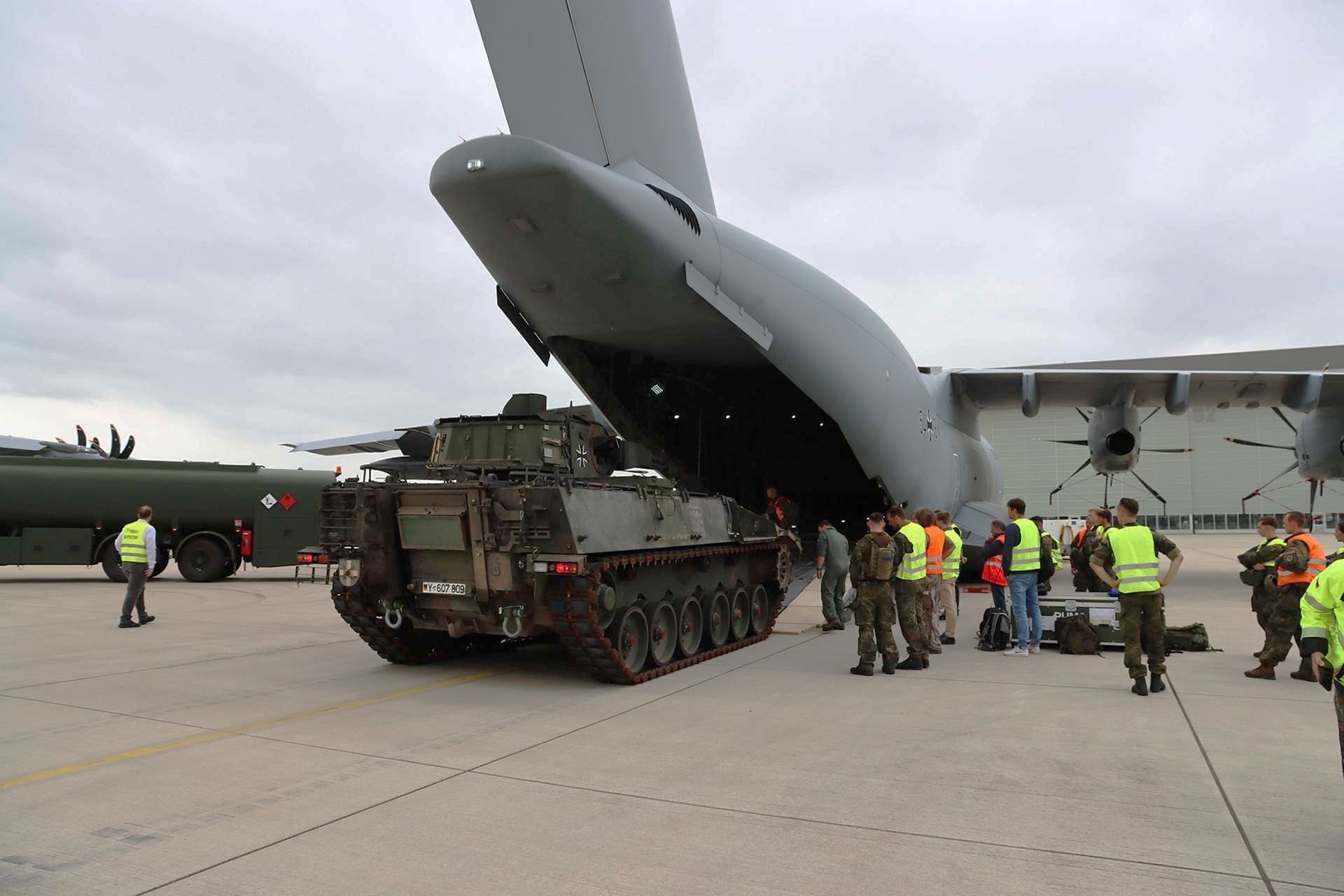Germany’s First A400M Transport Aircraft Airlifts Puma Infantry Vehicle Marking New Era of Rapid Armored Mobility

{loadposition bannertop}
{loadposition sidebarpub}
On July 9, 2025, Germany marked a significant milestone as, for the first time, a Puma infantry fighting vehicle was transported aboard an A400M military transport aircraft. This unprecedented operation, reported by ESUT, highlights Germany’s ongoing efforts to strengthen its rapid reaction capabilities and adapt its armored forces for modern, flexible deployments. The test involved close coordination between the Air Force, Army, procurement agency BAAINBw, and the Puma’s manufacturer, underscoring the strategic priority of airborne mobility for heavy armored units. As Europe faces evolving security dynamics, this breakthrough demonstrates a decisive shift in how the Bundeswehr envisions force projection far beyond its borders.Follow Army Recognition on Google News at this link
As the German Army refines these new loading and flight procedures, the Puma’s first flight aboard the A400M sets a precedent for faster, more flexible deployments, a critical factor in ensuring Europe’s collective defense remains robust and responsive (Picture source: German Army)
The Airbus A400M Atlas, known for its impressive payload capacity of up to 37 tons and versatile cargo hold, has already proven itself capable of transporting various armored vehicles such as the GTK Boxer. The Puma IFV, with its modular armor and advanced protection levels, required partial disassembly to remain within weight and dimension limits. Unlike lighter wheeled vehicles, the Puma’s tracked chassis and heavier protection packages posed a greater challenge for airlift. During this two-day operation, the vehicle was carefully pulled into the aircraft using the A400M’s onboard winch system, while hydraulically extendable stabilizers ensured the landing gear remained within safe stress limits, a crucial detail for maintaining the aircraft’s structural integrity during loading and flight.
Until now, the Puma, introduced into service to replace the aging Marder fleet, has primarily been deployed via rail or heavy transporters. This successful air transport test marks a turning point in its operational flexibility. Compared to the GTK Boxer, which has already been tested in split configurations for the A400M, the Puma required precise new procedures to handle its combat weight and center-of-gravity constraints. The operation not only validated the IFV’s transportability but also established detailed protocols for lashing and securing the vehicle, setting the stage for routine missions supported by two loadmasters and a tank driver in under two hours.
The ability to airlift the Puma brings notable tactical and strategic advantages. Unlike traditional road or rail movements, which can be time-consuming and vulnerable to infrastructure disruptions, air transport dramatically expands the Bundeswehr’s reach for rapid deployment within NATO’s area of responsibility. When compared with older IFVs or even other European tracked platforms, the Puma’s advanced armor, firepower, and digital systems, combined with the A400M’s range, enable Germany to reinforce distant frontlines or crisis regions swiftly. With Airbus already studying payload upgrades for the A400M fleet, the synergy between these systems could rival the airlift flexibility seen in other NATO forces using C-17 or C-5 aircraft for similar missions.
Strategically, this test reflects Germany’s broader push to ensure its armored brigades can respond rapidly to evolving threats in Eastern Europe or beyond. By proving that even heavily armored vehicles like the Puma can be deployed by air, Berlin signals its commitment to NATO’s forward defense posture and the ability to adapt high-value assets for expeditionary scenarios. In an era of contested mobility and hybrid warfare, such capabilities strengthen Germany’s deterrence and reassure allies of its readiness to act decisively when land routes may be compromised.
This milestone demonstrates that Germany is investing not only in modern equipment but also in the means to move it when and where it is needed most. As the Bundeswehr refines these new loading and flight procedures, the Puma’s first flight aboard the A400M sets a precedent for faster, more flexible deployments, a critical factor in ensuring Europe’s collective defense remains robust and responsive.

{loadposition bannertop}
{loadposition sidebarpub}
On July 9, 2025, Germany marked a significant milestone as, for the first time, a Puma infantry fighting vehicle was transported aboard an A400M military transport aircraft. This unprecedented operation, reported by ESUT, highlights Germany’s ongoing efforts to strengthen its rapid reaction capabilities and adapt its armored forces for modern, flexible deployments. The test involved close coordination between the Air Force, Army, procurement agency BAAINBw, and the Puma’s manufacturer, underscoring the strategic priority of airborne mobility for heavy armored units. As Europe faces evolving security dynamics, this breakthrough demonstrates a decisive shift in how the Bundeswehr envisions force projection far beyond its borders.
Follow Army Recognition on Google News at this link
As the German Army refines these new loading and flight procedures, the Puma’s first flight aboard the A400M sets a precedent for faster, more flexible deployments, a critical factor in ensuring Europe’s collective defense remains robust and responsive (Picture source: German Army)
The Airbus A400M Atlas, known for its impressive payload capacity of up to 37 tons and versatile cargo hold, has already proven itself capable of transporting various armored vehicles such as the GTK Boxer. The Puma IFV, with its modular armor and advanced protection levels, required partial disassembly to remain within weight and dimension limits. Unlike lighter wheeled vehicles, the Puma’s tracked chassis and heavier protection packages posed a greater challenge for airlift. During this two-day operation, the vehicle was carefully pulled into the aircraft using the A400M’s onboard winch system, while hydraulically extendable stabilizers ensured the landing gear remained within safe stress limits, a crucial detail for maintaining the aircraft’s structural integrity during loading and flight.
Until now, the Puma, introduced into service to replace the aging Marder fleet, has primarily been deployed via rail or heavy transporters. This successful air transport test marks a turning point in its operational flexibility. Compared to the GTK Boxer, which has already been tested in split configurations for the A400M, the Puma required precise new procedures to handle its combat weight and center-of-gravity constraints. The operation not only validated the IFV’s transportability but also established detailed protocols for lashing and securing the vehicle, setting the stage for routine missions supported by two loadmasters and a tank driver in under two hours.
The ability to airlift the Puma brings notable tactical and strategic advantages. Unlike traditional road or rail movements, which can be time-consuming and vulnerable to infrastructure disruptions, air transport dramatically expands the Bundeswehr’s reach for rapid deployment within NATO’s area of responsibility. When compared with older IFVs or even other European tracked platforms, the Puma’s advanced armor, firepower, and digital systems, combined with the A400M’s range, enable Germany to reinforce distant frontlines or crisis regions swiftly. With Airbus already studying payload upgrades for the A400M fleet, the synergy between these systems could rival the airlift flexibility seen in other NATO forces using C-17 or C-5 aircraft for similar missions.
Strategically, this test reflects Germany’s broader push to ensure its armored brigades can respond rapidly to evolving threats in Eastern Europe or beyond. By proving that even heavily armored vehicles like the Puma can be deployed by air, Berlin signals its commitment to NATO’s forward defense posture and the ability to adapt high-value assets for expeditionary scenarios. In an era of contested mobility and hybrid warfare, such capabilities strengthen Germany’s deterrence and reassure allies of its readiness to act decisively when land routes may be compromised.
This milestone demonstrates that Germany is investing not only in modern equipment but also in the means to move it when and where it is needed most. As the Bundeswehr refines these new loading and flight procedures, the Puma’s first flight aboard the A400M sets a precedent for faster, more flexible deployments, a critical factor in ensuring Europe’s collective defense remains robust and responsive.





